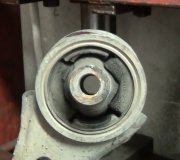That is better answered by your mechanic because we can't see those parts to make judgement calls. In general:
1. A torn or ripped cv joint boot will let dirt and water in and will prevent pushing the grease into the joint with each revolution. Usually replacing the boot right away will save the expensive joint, but on some car models that's a difficult and expensive job so it can be less expensive to replace the entire half shaft. If that applies to your car, I'd leave it go for now as long as you understand the whole shaft will need to be replaced in perhaps a year or two.
2. Serpentine drive belts don't break real often but if they're dry-rotted they can cause a squeal. The rule of thumb is it is acceptable for them to develop up to one crack per inch on the ribbed side. I can't find a listing of what the belt drives, but if it DOES break while you're driving, you could lose power steering, the charging system, and possibly the water pump. It's important to understand that you can still steer the car without power steering but the slower you go, the harder it will be to turn the steering wheel. At highway speeds you won't even miss the power steering, (assuming your car has it).
When the charging system quits, you can still drive up to about an hour if you don't turn on any unnecessary electrical accessories like the heater fan, head lights, radio, wipers, and things like that. Eventually the engine will stall, but long before that, if you stop the engine, it likely won't restart. Basically you can drive long enough to get to a repair shop.
Find out from your mechanic if the water pump is driven by this belt. Most are not. If yours is and the belt breaks, stop the engine as soon as possible but definitely not more than a minute or two to avoid overheating the engine. It's better to walk or call a tow truck than to risk overheating the engine. Doing so could result in an expensive leaking cylinder head gasket.
3. Need to know if it's sloppy or just noisy. Noise doesn't hurt anything but if it lets the belt wander around it could fall off or set up a squeal.
4. Air filter is a cheap and easy maintenance item you can do yourself.
5. Your mechanic had to remove the intake manifold to remove a spark plug to visually inspect it. Why didn't he replace them right away when everything was already apart? If he didn't have everything apart, he's just guessing at their condition based on mileage. At the mileage you listed the spark plugs should have been replaced at least once already.
6. "Cracked" can mean a lot of different things. Cracking due to dry-rotting is common and normal. That's not a reason to replace them. When they're worn enough to allow suspension parts move around, then it's time to replace them. The wheels will not stay in proper alignment leading to accelerated tire wear, and handling will not be as tight and responsive as normal.
7. There's four tie rod ends that form the links between the steering gear and the wheels. If any one of them separates, it's anyone's guess if you'll head into the ditch or oncoming traffic. These are safety-related items that shouldn't be ignored.
8. Same as # 6.
9. A little seepage from the valve cover gasket isn't abnormal, so it's a question of how much leakage. Have you been checking the oil level? How often do you have to add, and how much? Excessive oil leakage could lead to an engine fire. Minor seepage will vaporize off and leave a muddy but harmless residue behind.
None of these things should be ignored, but to find so much wrong all at once suggests the car hasn't had regular maintenance or the mechanic is nit-picking and trying to find any little thing that needs work. You might consider getting a second opinion from a different shop, and have them prioritize what is safety-related right now, and what can wait a little while.
Sunday, June 1st, 2014 AT 9:16 PM


